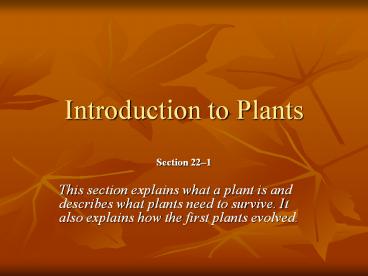Introduction to Plants - PowerPoint PPT Presentation
Title:
Introduction to Plants
Description:
Introduction to Plants Section 22 1 This section explains what a plant is and describes what plants need to survive. It also explains how the first plants evolved. – PowerPoint PPT presentation
Number of Views:257
Avg rating:3.0/5.0
Title: Introduction to Plants
1
Introduction to Plants
- Section 221
- This section explains what a plant is and
describes what plants need to survive. It also
explains how the first plants evolved.
2
What Is a Plant?
- Circle the letter of each sentence that is true
about plants. - Plants carry out photosynthesis.
- Plants have cell walls made of cellulose.
- Plants develop from multicellular embryos.
3
What Is a Plant?
- What pigments do plants use to carry out
photosynthesis? - They use the green pigments chlorophyll a and
b.
4
What Is a Plant?
- Is the following sentence true or false?
- All plants are autotrophs.
- False
5
The Plant Life Cycle
- All plants have a life cycle that is
characterized by alternation of .
6
Complete the table about plant generations.
7
The Plant Life Cycle
8
The Plant Life Cycle
- Seed plants have evolved reproductive cycles
that can be carried out without. - water
9
What Plants Need to Survive
- What are the four basic needs of plants?
- a. sunlight
- b. water and minerals
- c. gas exchange
- d. transport of water and nutrients throughout
plant body
10
Why are plant leaves typically broad and flat?
- Their shape maximizes light absorption.
11
Circle the letter of each sentence that is true
about the basic needs of plants.
- a. Plants require oxygen to support respiration.
- c. Water is one of the raw materials of
photosynthesis. - d. Plants have specialized tissues to carry
nutrients upward.
12
Early Plants
- The history of plants can be understood in terms
of the evolution of what kind of structures?
13
- It can be understood in terms of the evolution of
structures that acquire, transport, and conserve
water.
14
- What did the first plants evolve from?
- The first plants evolved from an organism much
like the multicellular green algae living today.
15
Circle the letter of each sentence that is true
about multicellular green algae.
- a. They have the same photosynthetic pigments as
plants. - b. They have the size, color, and appearance of
plants. - d. They have reproductive cycles that are similar
to early plants.
16
How were early plants similar to todays mosses?
- They were simple in structure and grew close to
the damp ground.
17
- From the first plants, at least two major groups
of plants evolved. What did those groups develop
into? - One group developed into mosses and their
relatives. The other group developed into all
other plants, including ferns, cone-bearing
plants, and flowering plants.
18
Overview of the Plant Kingdom
- Circle the letter of each of the important
features that botanists use to divide the plant
kingdom into four groups. - seeds
- water-conducting tissue
- Flowers
19
Overview of the Plant Kingdom
- What are the four main groups of living plants?
- Ferns and their relatives
- Flowering plants
- Mosses and their relatives
- Cone-bearing plants
20
Overview of the Plant Kingdom
- The great majority of plants alive today are
flowering plants. - flowering plants.































